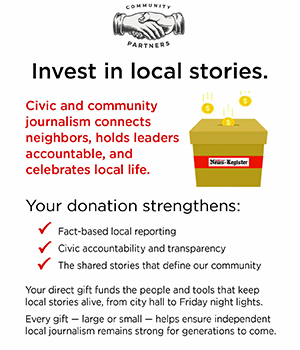Study up, then help build more stabilized housing
One of the many things I enjoy about working with our local Habitat for Humanity is how immediately recognizable it has become in the community.
When I’m introduced as the McMinnville ReStore manager, I know I won’t have to explain who we are, what we do or how we started.
Of course, that recognition isn’t always positive. For example, consider this comment:
“Oh, you’re the folks who give houses to poor people, all thanks to Jimmy Carter. Man, I wish I could get a fancy home for free. I’d sell that sucker in a heartbeat and make a bundle! It’s just a shame low-income housing ruins property values.”
OK. There may be a few of our neighbors not ready for a round of Jeopardy when the category is Habitat for Humanity. For those, here’s a quick history.
Habitat was founded in 1976 by Millard and Linda Fuller in Americus, Georgia. It has since spread to 70 countries around the world.
In the U.S. alone, Habitat serves nearly 1,400 communities. It has built, preserved or rehabilitated 800,000 homes during its 43 years.
Here at home, our McMinnville affiliate was launched in 1991 by Bernie Turner, Mark Trumbo and Verne Cooperrider.
Over the years since, we’ve built 61 homes. (Yay us!) And to single out just one longtime supporter, Washington Roofing has roofed every single one of those homes for free. (Yay them!)
No, Jimmy and Rosalyn Carter did not found the organization. But they are from Georgia, and they are longtime Habitat supporters and volunteers.
Their high profile brings national and international attention to the organization’s homebuilding work. And they annually lead the Jimmy Carter Work Project to raise awareness of the need for affordable housing.
So what about giving fancy homes to poor people?
While low income is one criterion, along with need and a willingness to partner, Habitat homeowners do have to carry a mortgage. Their mortgage payments help fund the next home, and the one after that and so on.
The loans are designed to be affordable.
The lower payment is made possible in part because much of the labor is volunteer. The commitment includes a significant portion provided by the recipient family itself — a minimum of 500 hours for a couple.
Numerous supplies and equipment component are donated by supporters like Lowe’s, Maytag, Valspar and others. That also helps keep cost down.
Fancy? Not quite.
Habitat’s philosophy is to build simple homes that are safe, decent and affordable.
While owning a home is unquestionably a giant step up from making do with a leaky single-wide or run-down apartment, Habitat homes are far from extravagant. Even in a four-bedroom home, living space is only about 1,300 square feet.
Well, how about selling a home for profit?
That would make no sense to a Habitat partner. They couldn’t relocate to anywhere near the same terms on the open market.
But just in case, any family choosing to move out is obligated to sell the home back to Habitat for the balance remaining on the mortgage, plus pay off a second mortgage reflecting the home’s actual appraised value.
But surely low-income housing lowers surrounding property values, right? Au contraire.
Study after study finds little or no evidence of low-income housing negatively affecting nearby property values. Conversely, it’s estimated the 61 Habitat homes in or near McMinnville generate $152,500 annually in property taxes, which helps the entire community.
And the benefits don’t stop there.
Looking further down the road, stable housing increases a child’s chance of graduating from college by 116%. And according to the Justice Policy Institute, “For populations that are most at risk for criminal justice involvement, supportive or affordable housing has been shown to be a cost-effective public investment, lowering corrections and jail expenditures and freeing up funds for other public safety investments.”
Now that we’ve cleared all that up, there’s one aspect of the organization that’s generally not well understood: Habitat is largely volunteer-driven.
Why, you ask, would someone spend time clearing brush, pounding nails, writing grants or organizing fundraisers, all for strangers?
President Carter said it this way:
“Habitat is not a sacrifice that we make for others. Habitat is a blessing for those of us who volunteer to help others.”
Our own volunteers reflect that sentiment. Ask them why they consistently give time to the organization, and you’ll get answers like these:
“I want to be part of something bigger than myself.”
“When we hand over keys to the new owners at a dedication ceremony, there’s often not a dry eye. I feel, at least in part, I helped make that happen.”
“Now that I’m retired, I love being able to put my experience to use. Habitat was able to match my strengths with the position.”
“I like the camaraderie of working with like-minded people.”
“I get a kick out of the customers at the ReStore.”
“I was a college professor. What did I know about building a house? But at Habitat, I learned a new skill. Now I do know how.”
Of course, there is more to the Habitat story. But for now, you should at least clear the first round of Jeopardy. And so, I leave you with the words of Mario, a Habitat homeowner:
“When I turn onto my street, most of the time I’m coming from work, maybe from a hard day. I see my house, and it just puts a smile on my face.
“My children love their new school. The bus isn’t crowded and the teachers are nice. It is a fun place, but they are getting a good education.
“The neighborhood is quiet — no gunshots, no violence, no kids running around in the street. People care.”
I can tell you it’s pretty cool to be part of these stories.
Want to join us? Visit www.machabitat.org and sign up!












Comments